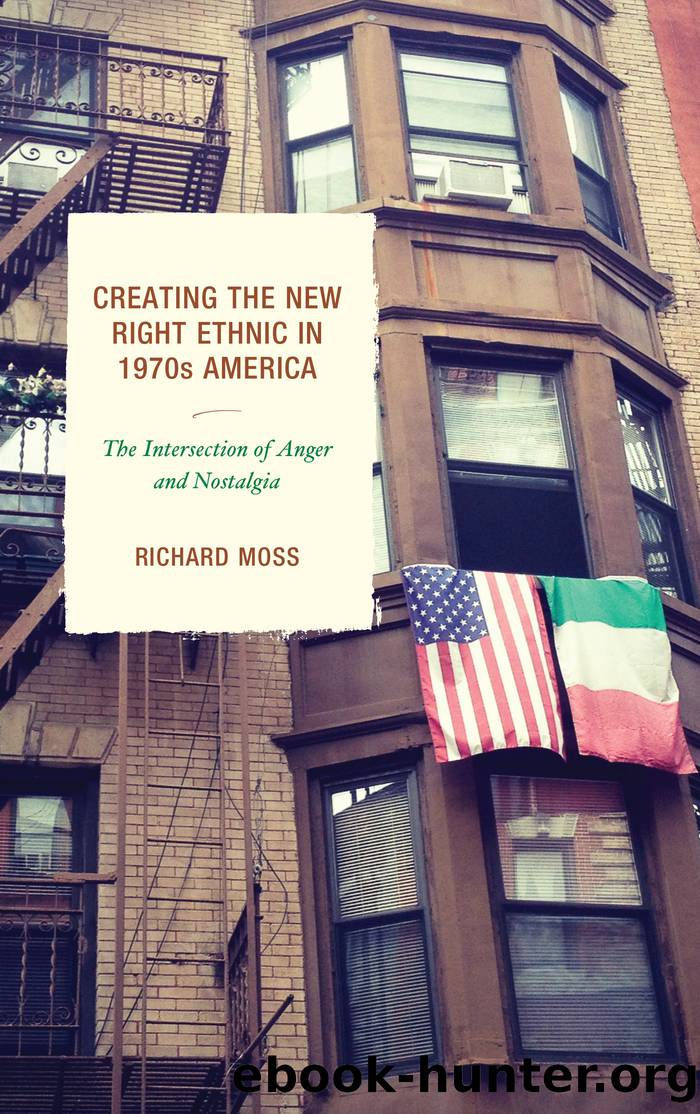Creating the New Right Ethnic in 1970s America by Moss Richard;

Author:Moss, Richard;
Language: eng
Format: epub
Tags: undefined
Publisher: Fairleigh Dickinson University Press
Published: 2012-08-15T00:00:00+00:00
âWe Have to Go Beyond the Old Civil Rights Struggles:â Ethnicity and Social Justice in the 1970s
While progressive New Ethnic groups like the Calumet Community Congress had emerged from grassroots efforts in working-class neighborhoods, the energy that they created, and the promise of a new approach to activism that they heralded, caught the attention of larger institutions such as the Ford Foundation that were interested in the same goals. At the same time, the support that more reactionary leaders like Kahane and Colombo received was alarming to the liberal leaders of these foundations, a development that encouraged them to look for alternate ways of approaching urban problems. As a result, grassroots activists like Baroni received money to create centralized, bureaucratic organizations that would serve as guides, clearinghouses, and funding sources for grassroots projects. Though these groups began considering white ethnicity as an important component of activism at the same time that smaller community-based organizations were emerging, they greatly influenced the course of the New Ethnicity. Indeed, their development and influence traced the same arc as the overall movement itself. As the New Ethnicity became more visible and delimited through the intellectual and cultural projects it inspired, centralized activist groups became more prominent and, like the movement, reached their highest point in the mid- to late 1970s.
If the national movement for progressive New Ethnic change owed its inspirationâand, later, its foot soldiersâto grassroots leaders, its logistical and financial origins lay with the American Jewish Committee. Founded in 1906 to protect Jewish interests, the American Jewish Committee had in the postwar years turned its attention to all minority groups in America, arguing that none was safe while others were persecuted.[3] As a result of this stance, its leaders looked at the urban crisis of the late 1960s with alarm and anxiety. A number of worrisome trends drove this response. As detailed in chapter 2, the increasing restiveness of âethnic Jewsâ challenged the Establishmentâs belief that Jewish liberalism and commitment to tolerance was unshakable. In addition, these Jews were aligning themselves with other white ethnic groups that the Committee had traditionally eyed warily. This alliance, leaders feared, would only stoke the violence and distrust in urban neighborhoods, a fear that was embodied by the Jewish Defense League and its efforts to recruit support among other conservative ethnic leaders. The upheavals in which Jews actively participatedâthe teacherâs strike and 1966 controversy over a civilian review board for the New York City police, as well as a more amorphous struggle over neighborhood integrationâârepresented a crucial departure,â in Arthur Gorinâs words. The âsoft pluralismâ advocated by Horace Kallen and others was being replaced by âa hard-nosed, if not a hard ânew pluralism.ââ[4] This new pluralism was more aggressive, vocal, and angry than its predecessor, and the Committee understood that it would have to be harnessed in order to head off the violence and mutiny at which its rhetoric often hinted.
At the same time, the AJC and other organizations recognized that the response of many mainstream progressive leaders was further fueling the anger and disillusionment of white ethnics.
Download
This site does not store any files on its server. We only index and link to content provided by other sites. Please contact the content providers to delete copyright contents if any and email us, we'll remove relevant links or contents immediately.
The Evidence of Things Not Seen by James Baldwin(237)
A Rome of One's Own by Emma Southon(236)
Executive Order No. 9066: The Terrible Injustice Of 1942 by Sollace Freeman(221)
The Explorers by Amanda Bellows(216)
A Wider Type of Freedom: How Struggles for Racial Justice Liberate Everyone by Daniel Martinez HoSang(194)
A Cultural History of Work in the Age of Empire by Victoria E. Thompson (ed.)(174)
Liberty's Dawn: A People's History of the Industrial Revolution by Emma Griffin(165)
The Grey Eagles of Chippewa Falls by John E. Kinville(161)
Respectability and Reform by Tara M. McCarthy(158)
The Crosswinds of Freedom by James MacGregor Burns(156)
Rethinking White Societies in Southern Africa by Duncan Money(153)
A Troublemaker May Surprise (The Troublemaker Series Book 2) by Genta Sebastian(145)
Evolution of Slavery Through the Ages: A Comprehensive World History of Slavery by PRESS VERITY(139)
Continental Strangers by Gemunden Gerd;(135)
A Teacher's Guide to Ladies of Liberty by Cokie Roberts Amy Jurskis(133)
The Slave Ship, Memory and the Origin of Modernity by Martyn Hudson(129)
Letters From London by Julian Barnes(129)
Beware the Masher by Kerry Segrave(120)
Hunger Dark Pen by Dark Pen(119)
